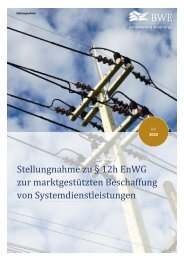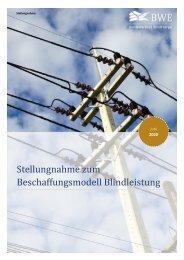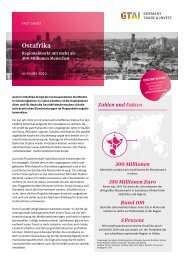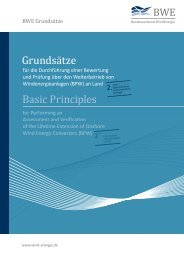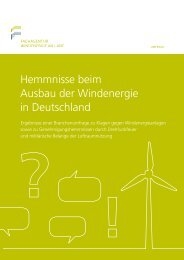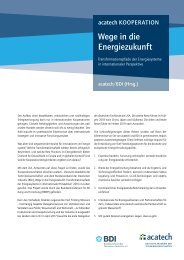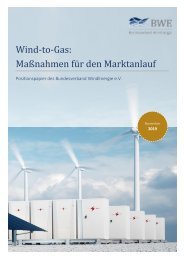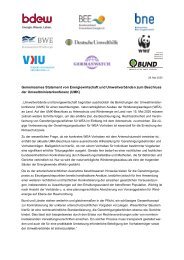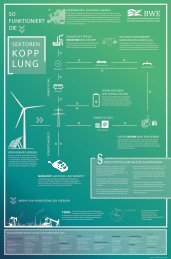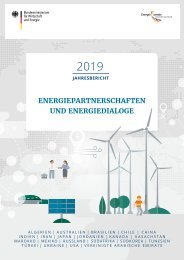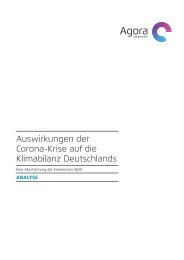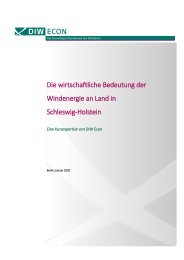Making transition work - Wind Europe
This report provides clear elements on how to make transition work in the coming decade. It provides recommendations to policymakers on how to facilitate a swift transformation of the energy system and considers the policies that will make Europe the best choice for those investing in renewables.
This report provides clear elements on how to make transition work in the coming decade. It provides recommendations to policymakers on how to facilitate a swift transformation of the energy system and considers the policies that will make Europe the best choice for those investing in renewables.
You also want an ePaper? Increase the reach of your titles
YUMPU automatically turns print PDFs into web optimized ePapers that Google loves.
<strong>Making</strong> <strong>transition</strong> <strong>work</strong>: policy<br />
FIGURE 12<br />
Minimum distance ranges to housing (m)<br />
2,500<br />
2,000<br />
1,500<br />
1,000<br />
500<br />
0<br />
DE PL IE AU DK FR EL ES PT CZ IT RO<br />
Source: <strong>Wind</strong><strong>Europe</strong><br />
some planning requirements have tightened in many<br />
Member States with regards to set back distances, noise<br />
limits or wind turbines interference with civil aviation and<br />
military radars.<br />
The requirement for minimum distances between wind<br />
turbines and housing varies significantly across the<br />
EU. Some countries have a single distance across their<br />
territory. Others instead, derive this value either based<br />
on the wind turbine tip height or the rotor diameter. In<br />
Italy, for instance, the setback distance can be minimum<br />
200m or it can be calculated as “6 times the turbine tip<br />
height”, depending on the region and other conditions. In<br />
Poland, the “10 times tip height rule” applies. Assuming<br />
the height of most modern wind turbines is around<br />
160m, the minimum distance from any residential zone or<br />
protected natural area would be 1.6Km. This represents<br />
a huge spatial planning barrier, significantly limiting site<br />
availability across the country.<br />
Repowering and life extension permitting is another area<br />
that requires improvement. National and EU legislators<br />
should set regulatory frame<strong>work</strong>s allowing to tap the<br />
potential repowering and lifetime extention represent<br />
to modernise the EU wind energy fleet and help the EU<br />
reach its renewable energy objectives.<br />
Member States’ 2030 national plans should provide<br />
legislation for repowering projects that allows them to to<br />
compete on a fair basis with new projects.<br />
3.4 REGIONAL COOPERATION<br />
Regional cooperation will be key to deliver on many policy<br />
fronts especially, but not only, in the <strong>Europe</strong>an seas, where<br />
offshore wind could be competitive within a decade.<br />
Member States cannot <strong>work</strong> in silos to achieve the set<br />
targets. Cooperation between nations to raise overall<br />
ambition and forge the agreements which will bring about<br />
the Energy Union is a prerequisite to success.<br />
<strong>Europe</strong>an countries have already achieved important steps<br />
in the implementation of the <strong>Europe</strong>an single market for<br />
electricity. Member States rely more and more on a set of<br />
common rules to trade electricity and to ensure security of<br />
supply. Day-ahead markets have been successfully coupled<br />
across <strong>Europe</strong>, leading to lower prices and increasing the<br />
value of renewable energy. Transmission System Operators<br />
(TSO) are adopting EU-wide net<strong>work</strong> codes to keep the<br />
lights on. These new rules aim to harmonise operating<br />
procedures, increase cooperation across borders and<br />
facilitate the deployment of renewable energy sources<br />
while maintaining system reliability.<br />
For example, increasing regional cooperation is already<br />
taking place when performing systems adequacy analyses.<br />
The first regional assessments are resulting in a common<br />
strategic vision on the role of capacity remuneration<br />
mechanisms as the last resort measure to guarantee<br />
security of supply 26 .<br />
26. Regional Generation Adequacy Assessment, Pentalateral Energy Forum, June 2015 http://www.benelux.int/files/4914/2554/1545/<br />
Penta_generation_adequacy_assessment_REPORT.pdf<br />
28 <strong>Making</strong> <strong>transition</strong> <strong>work</strong><br />
<strong>Wind</strong><strong>Europe</strong>



